Nocturnal turbulence at Jezero driven by the onset of a low-level jet as determined from MRAMS modeling and MEDA measurements
- 1Centro de Astrobiologia (CSIC-INTA), Department of Space Instrumentation, Torrejon de Ardoz, Spain (jpla@cab.inta-csic.es)
- 2Universidad del País Vasco (UPV/EHU), Bilbao, Spain
- 3Southwest Research Institute, Boulder, CO, USA
- 4Jet Propulsion Laboratory/California Institute of Technology, Pasadena, CA, USA
- 5Aeolis Research, Chandler, AZ, USA
- 6Paris Observatory, France
- 7ISAE-SUPAERO, Université de Toulouse, 31055 Toulouse, France
- 8Lunar and Planetary Institute, Houston, TX, USA
- 9Finnish Meteorological Institute, Helsinki, Finland
The aim of this investigation is to carry out a study of the variability of nocturnal atmospheric turbulence at Jezero crater supported by modeling effort and monitored by MEDA. The rapid turbulent kinetic energy (hereafter TKE), wind and pressure fluctuations observed during nighttime both with modeling and MEDA is a clear indicator of nocturnal turbulence. The origin of this nocturnal turbulence is explored with MRAMS and, as opposed to Gale crater, low evidence of significant gravity waves activity during the whole period studied was found. On the contrary, the nighttime turbulence at Jezero crater could be shear driven and may be explained due to an enhanced mechanical turbulence produced by increasingly strong shear (onset of a strong low-level jet) at the nocturnal inversion interface.
As the nocturnal inversion develops, the winds above become decoupled from the surface and the decrease in friction produces a net acceleration [refs 4, 5, 6, 7]. Once the critical Richardson Number is reached (Ri ∼< 0.25, Figure 3), shear instabilities can mix warmer air aloft down to the surface [refs 8, 9, 10].
1. Introduction
The Mars 2020 Perseverance rover landed in Mars in February 2021 at 18.44°N 77.45°E within and near the northwest rim of Jezero crater. The MEDA weather station is aboard Perseverance rover [ref 1].
2. MRAMS mesoscale simulations
MRAMS was applied to Mars 2020 landing site region using nested grids with a spacing of 330 meters on the innermost grid that is centered over the landing site [ref 2].
3. Nighttime turbulence modeled with MRAMS
The effect of subgrid-scale eddies is captured within MRAMS via a prognostic TKE (Figure 1) equation [ref 3]. MRAMS shows a peak in TKE during the afternoon, which is consistent with the modeled high-frequency variations in air temperatures [Figure 3 of ref 2]. The sudden increase in air temperature during the evenings [Figure 3 of ref 2] at the onset of radiative cooling is produced by mechanically driven turbulence since the atmosphere is stable and non-convective in the evening.
The model does often show small increases of TKE during the night (Figure 1), especially during Ls=180º (corresponding to Mars 2020 sol 362) and some during Ls 105 and Ls 160 (corresponding to Mars 2020 sols 216 and 326), that could be associated with the turbulent aspects of the nighttime dynamical flows when compared with nearby locations with more flat topography. During the late evening and night, MRAMS is resolving thermal variations [2, Figure 3] and does often show small increases of TKE at that time (Figure 1). The rapid air temperature fluctuations modeled at night in all seasons is indicative of nocturnal turbulence.
There is low evidence of significant wave activity during the whole period studied and only some gravity waves were found. The nighttime turbulence could be attributed to shear driven turbulence and may be explained due to an enhanced mechanical turbulence driven by increasingly strong shear, with the onset of the nocturnal low-level jet, at the nocturnal inversion interface (an example on Figure 2). Based on GCM model efforts, looks like the low-level jet is a large scale circulation feature. The westward wind at 2 km altitude shown on Figure 2 is also show up nicely in the MCD. The jet could be forced by the diurnal cycle.
The dustier atmosphere, when arrival of northern autumn equinox, also contributes to decrease the nighttime Richardson number by two means: strengthening of the nighttime low-level jet deeping the near-surface wind shear and weakening near-surface atmospheric stability by increasing the nighttime surface temperature and decreasing of atmospheric temperature.
A third possible strengthening of the nighttime turbulence at Jezero could be the convergence, after 01:00 LTST, of downslope winds blowing from NW rim fighting against SE winds blowing both from east crater rims and from Jezero mons (located SE outside the crater), producing a big whirlpool inside the crater (Figure 4) that could be the responsible of the high variability of wind directions observed by MEDA.
4. Nightime turbulence observed with MEDA
The rapid fluctuations of pressure (moreover during high dust periods), TKE (derived only with horizontal wind speeds, that will be updated with vertical winds in the future) and wind speeds observed during nighttime with MEDA (Figures 5 and 6) is a clear indication of nocturnal turbulence.
5. Figures
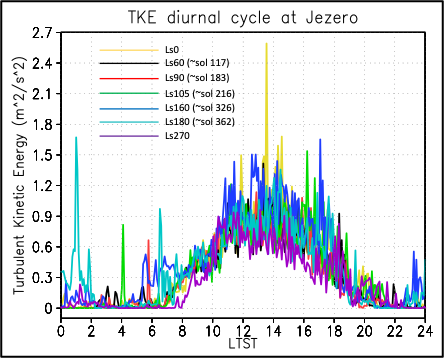
Figure 1: TKE diurnal cycle predicted with MRAMS for Jezero crater at Ls0, 60, 90, 105, 160, 180 and 270.
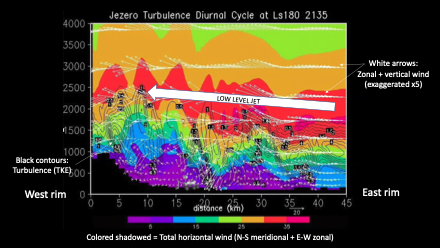
Figure 2: MRAMS vertical cross-section (Jezero’s west rim to east rim) at 21:35 LTST of Ls=180º -corresponding to Mars 2020 sol #362- of total wind (zonal + meridional) in colored shadowed, zonal + vertical (exaggerated x5) wind in white arrows and TKE in black contours. The west crater rim is the hill on the left. Perseverance rover is located at x ≈ 17 km.
Figure 3: MRAMS vertical profiles of wind magnitude, wind shear, Richardson number (Ri) and TKE for Ls180 at Mars 2020 location corresponding to Mars 2020 sol #362 (Ls=180º). Once the critical Richardson Number is reached (Ri ∼< 0.25, red line).
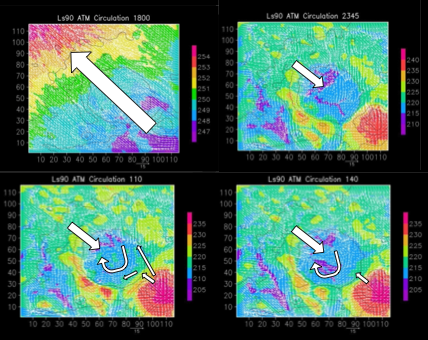
Figure 4: Near-surface winds (vectors) and potential temperature (shaded) as predicted on numerical grid 5. Vectors are plotted at every other grid point. Topography contours are shown in black. Wind vector scale is shown in the bottom right area of the panels. hh:mm LTST on the top right. A big whirlpool inside the crater could be responsible for the large variability of wind directions observed by MEDA after 01:00 LTST.
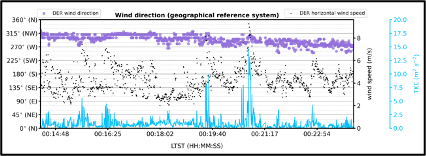
Figure 5: MEDA TKE (derived only with horizontal wind speeds, that will be updated with vertical winds in the future), wind direction and horizontal wind speed instantaneous measurements for the period 00:14 to 00:23 LTST at sol #73.
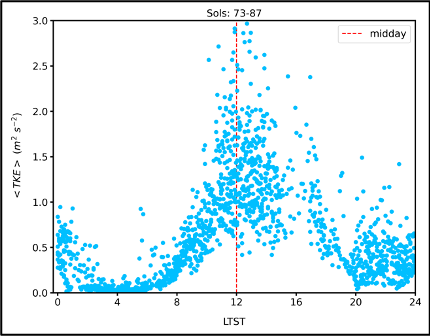
Figure 6: Diurnal cycle of MEDA TKE averaged over 5 min for sols #73-87.
6. References
[1] Rodriguez-Manfredi et al. 2020; [2] Pla-Garcia et al. 2021; [3] Mellor and Yamada 1974; [4] Davis 2000; [5] Blackadar 1957; [6] Thorpe and Guymer 1977; [7] Mahrt 1981; [8] Miles 1961; [9] Banfield et al. 2020; [10] Chatain et al. 2021
How to cite: Pla-Garcia, J., Munguira, A., Rafkin, S. C. R., Hueso, R., Sánchez-Lavega, A., de la Torre, M., Viúdez-Moreiras, D., Newman, C., Bertrand, T., del Río, T., Murdoch, N., Martínez, G., Savijarvi, H., Chide, B., Richardon, M., and Rodríguez-Manfredi, J. A.: Nocturnal turbulence at Jezero driven by the onset of a low-level jet as determined from MRAMS modeling and MEDA measurements, Europlanet Science Congress 2022, Granada, Spain, 18–23 Sep 2022, EPSC2022-390, https://doi.org/10.5194/epsc2022-390, 2022.

